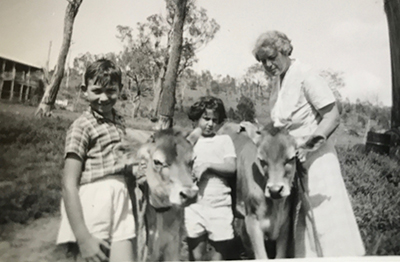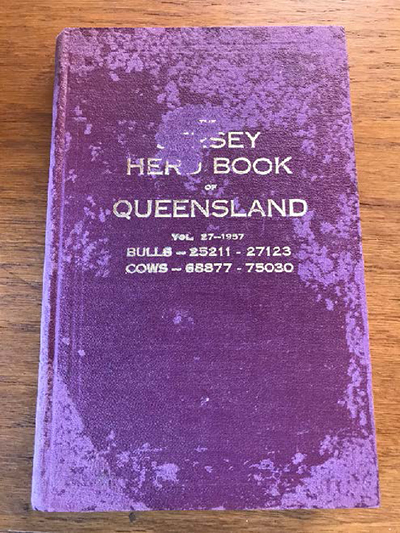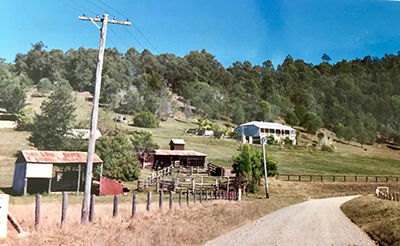
by Roy Curry
Long before I began to trace the Milne/Curry Human Family tree, I learned about ancestry for cows. My education in this topic came as part of the development of a herd of Jersey cows on the Wonglepong Farm in southern Queensland, Australia by my parents Bert and Doris Curry. Wonglepong is an Aboriginal place name for a region about 50 miles south of Brisbane. It was there that my parents build a life together after their long separation during World War II.
At least most of the time. Doris was a city girl, ten years younger than Bert. The nearest she had previously come to a farm was her rose garden.
Bert was in his early 50’s. His face, with dry and wrinkled folds, showed a life spent outdoors in the fierce Queensland sun, working mainly on other people’s farms after the Great Depression robbed him of his first farm. The twinkle in his eyes helped to keep Doris devoted to this new enterprise. At least most of the time. Doris was a city girl, ten years younger than Bert. The nearest she had previously come to a farm was her rose garden.
There was little contact with our extended family. Bert took us to visit brothers occasionally but we knew little about his parents, both from England. They had separated and died before the war. Doris, a youngest daughter, had cared for her widowed mother, without much support from siblings. She was closest to a small group of friends, all schoolteachers, known before and during the war. Doris had brothers, uncles, a grandfather and grandmother, and a great grandfather who had all been teachers either in Scotland or Queensland. At this stage in her life, she took a short break from teaching for her human and bovine families.

The name of the family of cows was “Elroy,” formed by combining the names of my sister “ Ellen” with mine, “Roy.” The extract below is from a book called, The
Jersey Herd Book of Queensland Vol. 27 in 1957, published by The Jersey Cattle Society of Queensland. Jersey cows are “creamy” both in color and the richness of their milk. The extract below gives the registration of one of the first heifers, young female cows, born into this new herd.
Her name was Elroy Banner’s Royal Lass. Her father or sire was Trinity Banner Royal, bred by Sinnamon and Sons who owned the Jersey family called “Trinity” and bought by Bert and Doris Curry to be the first of the bulls to be used for breeding. The calf’s mother was Eumirvel Vain Lass bred by J. Colvin, one of “the jersey farming gentry” at Beechmont not far from our farm. Vain Lass was one of several mature cows bought to help begin the new herd. So the new calf’s name was a combination of “Banner Royal” and “Lass” with the other combined name “Elroy “ upfront to announce the new arrival born June 24, 1955 as part of the Elroy Jersey Stud. She had a number in the book (74073) which enabled her pedigree to be found and searched (for me, by hand of course, at night by the light of a kerosene lamp). The tentacles of rural electrification were extending from the nearest small town, but had not yet reached much of Wonglepong.
At age 10 I could spend hours with the herd book. Starting with her father ‘s name, “Banner “ for short, and number 24184, I could find Elroy Banner’s Royal Lass’s sisters and cousins by searching the lists of other “Trinity” and “Eumirvel” entries. Sixty years later at least one copy of the Herd book survives, and sits on my bookshelf.
I had combed her coat, polished and lacquered her horns and hooves, and plaited and combed the brush on her tail. The first time I ever had to know about a girl’s make-up.
Milking Time! The farm dairy sat close to paddocks that were flat enough to be plowed, irrigated, and sown with grass combinations recommended by the new science of agricultural pasture improvement. The farmhouse, sited a little further away on a hill, overlooked this most active part of the farm and the Canungra Creek for which this valley was named. The small school bus had dropped my sister and me home from school five miles away, and after a quick afternoon tea, I was beginning to be actively involved with the working end of life on a dairy farm: milking cows, feeding calves, and watching with my father for the signs that any one of the new cows was ready to “spend time with Banner,” ancestry in the making.

My favorite cows were Spring Song 2nd and Some Jingles from the jersey stud “Tecoma,” owned by A.L. Semgreen. A year earlier I had prepared Spring Song, an 18-month-old heifer, as my entry in the Canungra Primary School Project day. I had combed her coat, polished and lacquered her horns and hooves, and plaited and combed the brush on her tail. The first time I ever had to know about a girl’s make-up. She did not win a prize but she was now old enough to calve, adding to the growing Elroy jersey family, and be milked.
On most days this was a routine process using the milking machine, but on occasions her milk was tested to check that she lived up to the expectations of all that ancestry and “family planning”. Her milk that had such a high percentage of cream that it would ensure the local butter factory was supplied with the dense cream for both butter and excellent ice-cream. Some also found its way to the farmhouse kitchen.
With Ancestry.com I have extended human family stories well beyond the missing paternal grandparents and those maternal ancestors who graduated from Aberdeen University as early as 1814 before sailing to Australia. Some were possibly hoping to find gold, but found different riches as educators. But I lost the trail of that Jersey herd after my father died and the farm was sold. The Herd book on my shelf is my sole link to another family that, with a slight “mootation,” can be called Ancestry.cow.
